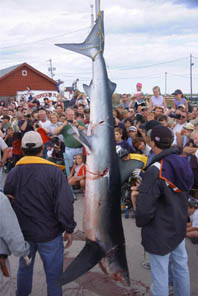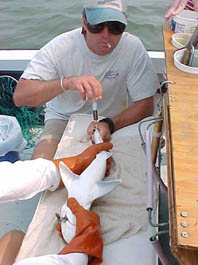
![]()
Volume 7, No. 2
Promoting Cooperation to Maintain and Enhance
Environmental Quality in the Gulf of Maine
|
||||||||||
|
Regular columns |
|
|
|||||||
|
|
|
|
Browse the archive |
|
|
|
|
The truth about sharks:
As understanding about some species grows, so too do concerns about their future
By Andi Rierden, Editor
For millions of years, sharks cruised the oceans as the top predator–like the lion on land–with little interference. Designed by nature to be long-living, slow-growing and late maturing, they bear only a few young each year. Some breed only every other year. Yet in recent decades, heavy fishing has exerted an unnatural toll on several shark species. Due partly to the expansion of fishing fleets in the open ocean and the collapse of traditional fisheries like cod, the ocean's dominant hunter has increasingly become the hunted.
In the face of slow reproduction, scientists say, these animals are simply unequipped by evolution to withstand such abrupt exploitation.
Precisely how many sharks are killed each year and how many are left is the subject of intense debate. With limited resources for shark research, documentation of life history characteristics and population trends exist for only a handful of the 360 known species.
According to one estimate by the United Nations Food and Agriculture Organization, over the past 50 years the worldwide catch of all elasmobranchs-sharks, skates and rays-has quadrupled, from 200,000 metric tons a year to 800,000. Because a large percentage of sharks are caught unintentionally in longlines and gillnets and go unreported, some researcher estimate that about 100 million sharks are killed by humans annually.
Earlier this year, a study by researchers at Dalhousie University in Halifax, Nova Scotia, published in the journal Science brought world-wide attention to the severity of the overfishing of sharks and provided the first detailed overview of an oceanwide decline with major implications.
"We estimate that all recorded shark species with the exception of makos have declined by more than 50 percent in the past eight to fifteen years," the researchers wrote. The area studied included coastal and deep waters from Newfoundland to northern Brazil. The researchers found that hammerhead sharks had declined by 89 percent in the Atlantic, threshers by about 80 percent and great white sharks by 79 percent.
Fishing off the top of the food chain may change the ecological structure and function of the ocean, the researchers wrote, "pervasive overfishing of these species can initiate major ecological changes."
The researchers examined scientific observer data and data from the logbooks for pelagic longline fleets (American) in the Northwest Atlantic targeting swordfish and tuna. They found trends using various statistical models to analyze catch records.
Since the study was published, some scientists have expressed skepticism about the some of the findings, particularly the drop in hammerheads of 89 percent. U.S. federal fisheries officials had measured smaller declines in hammerheads and other coastal species and saw signs that some species, like blacktip sharks, were making a steady comeback.
Others, like David O. Conover, a professor of biology at the Marine Sciences Research Center, State University of New York, said he found the study "a particularly clear and compelling example where a group of species that are bycatch in commercial fishing are suffering a decline that has gone unrecorded."
The spiny dogfish saga
While researchers in the Gulf of Maine region and elsewhere continue to expand their understanding of some shark populations, translating that science into sustainable management programs is a biologically complex and politically sensitive task. A classic example revolves around the spiny dogfish. Fishermen used to throw away the dogfish they unintentionally caught in cod nets, but began targeting the species in the early 1990s as cod stocks disappeared and demand in Britain for fish and chips grew. By 1996, U.S. stock assessments showed that the dogfish population, particularly mature females, was being depleted. The species was declared overfished in 1998. Regulations beginning in the spring 2000 have cut the quota and limited fishing to half the year.
The restrictions remain a hotbed of contention between conservationists, who have applauded the measures, and fishermen and processors who say there are plenty of dogfish in the sea. Massachusetts is the largest dogfish hauler in the United States and supports an industry that employs hundreds of people.
 |
| Blue Shark caught in Nova Scotia tournament. Photo: Dr. Steven Campana |
The issue is particularly complicated by the dogfish's biology.
While the fish are in fact abundant, scientists say the important question is not how many fish there are, but whether the catch is sustainable. Female dogfish do not reach sexual maturity until age 12. While much younger female codfish, for example, produce five million eggs a year, the spiny dogfish bears live pups, about six at a time, after a gestation period of 22 to 24 months.
The closing of the year-round fishery in the United States presents ramifications for spiny dogfish that migrate into Canadian waters. The Department of Fisheries and Oceans (DFO) has recently imposed its first quota on the small but growing dogfish fishery, though it is not scientifically based. At the Canadian Shark Research Laboratory in Dartmouth, Nova Scotia, Dr. Steven Campana and his team are currently analyzing fishing data from the United States and Canada that will ultimately shape regulations and management for the spiny dogfish in Atlantic Canada.
"I feel it's my mission to make certain these sharks don't go the way of the cod," says Campana. Depending upon their analysis, Campana says a plan for the dogfish may be similar to the one recently imposed on the porbeagle fishery. Using catch records and tagging data, Campana collaborated with scientists at the Cooperative Shark Tagging Program in Narragansett, Rhode Island, run by the National Marine Fisheries Service, to determine that the porbeagle population was seriously depleted. As a result of their findings, DFO reduced the porbeagle quota by 80 percent and closed an important nursery area for porbeagles off southern Newfoundland to fishing. Curbing overfishing and setting aside reserves in areas where sharks raise their young is key in sustaining healthy shark populations, Campana says.
Shark tournaments
Both Canada and the United States support catch and release recreational fisheries for the blue shark. The species is also the dominant catch in the handful of shark tournaments held each summer in Nova Scotia and Massachusetts. The Massachusetts Division of Marine Fisheries (DMR) operates a fishing tournament monitoring program that surveys participants to collect catch information on the weight, length and sex of the animal. The data are used to help assess the health of overall populations, says Greg Skomal, a shark biologist for DMR and the project's coordinator. Of the 1,138 sharks caught in 2002, 93 percent were released. Of these, 93 percent were blue sharks, seven percent were shortfin makos and less than one percent were common thresher sharks. About 30 of the sharks were landed and used for laboratory research. The meat was processed and donated to the Greater Boston Food Bank.
 |
| Greg Skomal, taking blood samples from a sand shark (note the syringe cap, not cigarette, in his mouth). Photo courtesy of Greg Skomal |
The tournaments can draw around 1,000 onlookers, says Skomal, and are used to educate the public about shark behavior and identity. "It's not like 20 years ago where you'd have tournaments in New York and a 1,000 dead sharks would end up in the dump," he says. "These days tournaments are monitored and used to instill an awe and respect for these animals. We don't want people out there catching sharks so they can go around beating their chests." Researchers in Canada run a similar data collection program at tournaments to determine shark numbers, characteristics and health.
While little is known about the impact of commercial and recreational fisheries and tournaments on the health of blue sharks, data now being collected in New England and Atlantic Canada are being pooled with other countries to produce the first North Atlantic population assessment for the species. The International Convention for the Conservation of Atlantic Tunas (ICCAT) has agreed to act as the central storing house for shark data and will be conducting the assessments in 2004. From there, say observers, it is a matter of countries complying with ICCAT regulations on a voluntary basis to create sustainable management plans. Shark biologists say the assessment may offer the best hope for the blue shark, whose migration pattern spans across the oceans.
While scientists and policy makers struggle to come to some consensus over the level of shark declines, conservationists say that should not stop governments from applying the precautionary rule to fisheries management of sharks.
"Sharks don't recognize international boundaries," says Sonja Fordham, a shark specialist with the Ocean Conservancy. "Shark-fishing nations need to work together to conserve the sharks they share."
Meanwhile, the Canadian Shark Research Laboratory is set to begin studies on another species, the basking shark. This migratory, slow swimmer found off Atlantic Canada during the summer months is the second largest sharkin the world. The research will be used to determine migration routes and the level of exchange between Canadian and U.S. waters. Referred to as the ocean's gentle giants, basking sharks are often killed or injured by boats or fishing gear. Their huge fins also sell for thousands of dollars for use in Asian shark fin soup or for display in restaurants that sell the soup (see sidebar below).
As far as the population in Atlantic Canadian waters is concerned, Campana says, "We know very little about them, but I have a gut feeling that they are in trouble."
To learn more about sharks research in the Gulf of Maine and elsewhere access:
Canadian Shark Research Laboratory:
http://www.mar.dfo-mpo.gc.ca/science /shark/
Massachusetts Division of Marine Fisheries:
http://www.state.ma.us/dfwele/dmf/